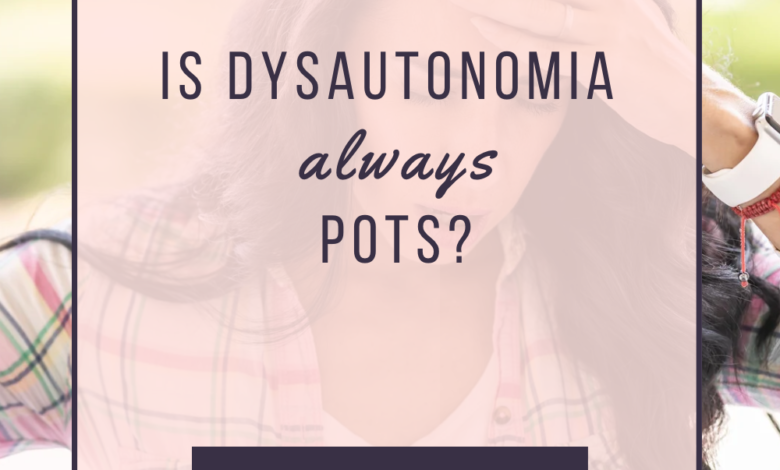Is Dysautonomia Always POTS? – An Ideal Life

When we hear the term “dysautonomia,” many of us immediately think of Postural Orthostatic Tachycardia Syndrome (POTS). This association is common because POTS is one of the most recognized forms of dysautonomia, especially within the chronic illness community. But is dysautonomia always POTS? Dysautonomia encompasses a broad spectrum of autonomic nervous system (ANS) disorders, each with its unique characteristics and challenges.
Understanding Dysautonomia
Dysautonomia refers to a range of medical conditions caused by a malfunction of the autonomic nervous system, which controls involuntary bodily functions such as heart rate, blood pressure, digestion, and temperature regulation. When the ANS doesn’t work properly, it can lead to a variety of symptoms that significantly impact a person’s quality of life.
Types of Dysautonomia
While awareness of POTS is growing, it’s just one of many types of dysautonomia.
A Closer Look at POTS
Postural Orthostatic Tachycardia Syndrome (POTS) is a condition where a change from lying to standing causes an abnormally large increase in heart rate. This can lead to symptoms such as lightheadedness, fainting, and rapid heartbeat, significantly affecting daily activities. POTS predominantly affects young women and can be associated with other conditions such as Ehlers-Danlos syndrome, mast cell activation disorders, and chronic fatigue syndrome. But the question at hand is this: is dysautonomia always POTS?
Neurocardiogenic Syncope (NCS)
Also known as vasovagal syncope, NCS is the most common cause of fainting. It occurs when there is a sudden drop in heart rate and blood pressure, leading to reduced blood flow to the brain and causing a person to pass out.
Inappropriate Sinus Tachycardia (IST)
IST is characterized by an abnormally high resting heart rate that exceeds what is considered normal for a person’s age and level of activity. Unlike POTS, the heart rate remains elevated regardless of postural changes. This is my current theory for my particular case of dysautonomia!
Orthostatic Hypotension
This condition involves a significant drop in blood pressure upon standing, leading to dizziness, fainting, and other symptoms. It is often seen in older adults and can be a side effect of certain medications.
Familial Dysautonomia (FD)
Familial dysautonomia is a genetic disorder that affects the development and function of the autonomic and sensory nervous systems. FD is characterized by a lack of tears, insensitivity to pain, and fluctuations in blood pressure and body temperature.
Pure Autonomic Failure (PAF)
PAF is a disorder characterized by a progressive decline in autonomic function, leading to severe hypotension (a drop in blood pressure upon standing), which can cause dizziness, fainting, and other symptoms.
Multiple System Atrophy (MSA)
MSA is a rare, progressive neurodegenerative disorder that affects the body’s involuntary functions, including blood pressure, breathing, bladder function, and motor control. MSA is often mistaken for Parkinson’s disease due to similar symptoms. In this case, you might be more likely to ask “Do I have Parkinson’s?” than “Is dysautonomia always POTS?”!
Autoimmune Autonomic Ganglionopathy (AAV)
AAG is an autoimmune disorder where the body’s immune system attacks the autonomic ganglia, causing a wide range of autonomic symptoms, including severe orthostatic hypotension and gastrointestinal issues.
Baroreflex Failure
This rare disorder involves the failure of the baroreflex mechanisms, which helps regulate blood pressure. Patients with baroreflex failure experience episodes of extremely high or low blood pressure, leading to headaches, chest pain, and other symptoms.
Hereditary Sensory and Autonomic Neuropathy (HSAN)
HSAN refers to a group of inherited disorders that affect the sensoy and autonomic nerves. Symptoms include insensitivity to pain, temperature changes, and autonomic dysfunction such as sweating abnormalities and blood pressure issues.
Autonomic Dysreflexia (AD)
Common in individuals with spinal cord injuries, AD is a life-threatening condition where there is an overreaction of the ANS to stimuli belo the level of injury. This can lead to sudden high blood pressure, severe headaches, and other complications.
Diabetic Autonomic Neuropathy
This form of dysautonomia occurs in people with diabetes and affects various autonomic functions. Symptoms of diabetic autonomic neuropathy can include gastrointestinal issues, bladder dysfunction, and cardiovascular problems.
Congenital Central Hypoventilation Syndrome (CCHS)
CCHS is a rare genetic disorder that affects breathing control. Patients with CCHS have trouble sensing and responding to low oxygen and high carbon dioxide levels, particularly during sleep.
Paroxysmal Sympathetic Hyperactivity (PSH)
Also known as “storming,” PSH is characterized by episodes of excessive sympathetic nervous system activity, causing symptoms such as rapid heart rate, high blood pressure, sweating, and muscle rigidity. It often occurs in individuals with severe brain injuries.
Postprandial Hypotension
This condition involves a drop in blood pressure after eating, leading to dizziness, lightheadedness, and sometimes fainting. It is more common in older adults and those with exiting autonomic dysfunction.
So, Is Dysautonomia Always POTS?
While POTS is a significant and often debilitating condition, it isn’t synonymous with dysautonomia. The umbrella of dysautonomia covers a wide range of disorders, each requiring its own specific diagnostic approach and management strategy. Misunderstanding this can lead to underdiagnosis or misdiagnosis.
In my own experience, I was diagnosed with NCS in middle school, with fainting episodes every so often since. When I started experiencing new dysautonomia symptoms, like feeling lightheaded with postural changes, my doctor and I suspected POTS, especially knowing its overlap with my other conditions, like fibromyalgia. A trip to the cardiologist, though, quickly ruled out a POTS diagnosis.
Answering the question of “Is dysautonomia always POTS?” and generally raising awareness about the various types of dysautonomia is crucial for several reasons.
- Accuate Diagnosis: Many patients struggle for years without an accurate diagnosis due to the lack of awareness about the full spectrum of dysautonomia.
- Tailored Treatment: Each form of dysautonomia may require a different treatment strategy. Awareness ensures that patients receive the most effective care.
- Support and Advocacy: Understanding the diversity within dysautonomia fosters a more inclusive and supportive community for all patients affected by autonomic disorders.
Living with Dysautonomia
For those living with any form of dysautonomia, managing symptoms and improving quality of life can be challenging. Here are a few general tips that might help:
Stay Hydrated
I know, I know—you’re sick of hearing this one! But still, it’s important enough to mention yet again. Drinking plenty of fluids can help maintain blood volume and alleviate some symptoms of orthostatic intolerance.
Monitor Your Salt Intake
Increasing your salt intake (under medical supervision) can help raise blood pressure in some types of dysautonomia. It’s crucial to consult with your medical team first though—in my case, I have to balance dysautonomia symptoms with other conditions, including hypertension, so I can’t simply reach for the salt shaker.
Invest in Compression Garments
Wearing compression stockings or abdominal binders can help prevent blood pooling in the legs. Check out my review of Vim & Vigr compression socks for inspiration! I also really like my pairs of compression socks from Wellow.
Take Your Medications
There are various medications that can help manage symptoms so, if you’ve been prescribed something that helps, be sure to take it as directed (easier said than done if you deal with executive dysfunction!).
Make Lifestyle Adjustments
Small changes, such as elevating the head of the bed, avoiding prolonged standing, and breaking up meals into smaller portions, can make a significant difference.
The Big Question: Is Dysautonomia Always POTS?
Dysautonomia is a complex and multifaceted family of conditions—so is dysautonomia always POTS? Nope. By broadening our understanding of dysautonomia’s various forms, we can better support those affected and promote more accurate diagnoses and treatments.
Source link



